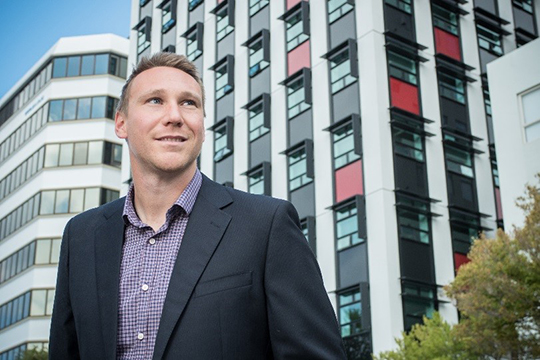Zeroing in on energy efficient buildings
A Victoria University of Wellington study shows that retrofitting New Zealand’s commercial buildings to use less fossil fuel-generated energy could save enough energy to power many homes in the South Island.

Research from Shaan Cory, who will graduate with a PhD in Architecture from Victoria next week, investigated whether New Zealand’s current commercial building stock could be converted to net zero energy.
“A net zero energy building is one that is energy efficient, and offsets any energy that was generated from greenhouse gas emitting fuels with renewable energy generation such as hydro, solar and wind,” says Shaan.
He found the current commercial building stock could be converted to eliminate the use of greenhouse gas emitting energy without New Zealand needing to generate more renewable energy.
Shaan’s research shows the energy saved by retrofitting all commercial buildings could power 330,000 homes. The reduction in greenhouse gas emissions would be equivalent to the methane emissions produced by 200,000 dairy cows.
Converting all of New Zealand’s commercial buildings may seem a large task, says Shaan, but half of the net zero energy target could be achieved by retrofitting just 1,200 of the largest of New Zealand’s 27,000 commercial buildings. The savings from these large buildings would be equal to the annual electricity generated by all wind turbines in New Zealand.
“A net zero energy building stock would lower climate change-inducing carbon emissions, improve energy security for New Zealand, and create buildings that provide better thermal comfort for their occupants.”
Shaan reached his findings by constructing energy models for a sample of existing buildings, matching their attributes and energy performance. The models were then retrofitted with a set of energy conservation measures.
He says the most effective energy saving techniques are more efficient plug-in equipment, lighting, heating, ventilation and air-conditioning, and the installation of electric light-dimming.
Shaan currently works as a building scientist at engineering firm Beca where he focuses on sustainable design and energy management to reduce the energy consumption, costs and greenhouse gas emissions of buildings.
His research was supervised by Associate Professor Michael Donn and Emeritus Professor George Baird from Victoria’s School of Architecture.
For more information contact Shaan Cory on 04 550 5990 or shaan.cory@beca.com.
